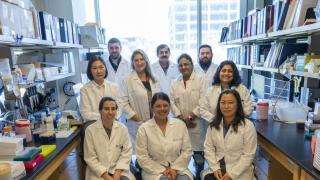
Debbie Thurmond Lab
Our science focuses on multitasker messenger proteins that play a beneficial role across multiple types of tissue. In this case, those proteins both increase the production of insulin — essential to the body’s ability to process sugar — and improve the capacity of skeletal muscle to make use of insulin.
What we discovered about how those proteins work and how to manipulate them will ultimately help to develop innovative cellular treatments for fighting type 1 and type 2 diabetes. Other projects in the Thurmond Lab focus on new biomarkers for detecting the development of diabetes.
Thurmond Lab Research Highlights
The Thurmond Lab’s focus encompasses research into SNARE-mediated vesicle trafficking events and cytoskeletal signaling as they pertain to the causes of diabetes. We have discovered that people with diabetes harbor defects and deficiencies in certain vesicle trafficking proteins. We are actively devising strategies to remediate these defects.
The proteins that we study — syntaxin 4 (STX4), p21-activated kinase (PAK1) and Doc2b — play significant roles in insulin production, as well as insulin and glucose uptake by skeletal muscle and fat tissues. We have found that depleted STX4 and PAK1 reduce insulin release and sensitivity, while overexpression of STX4 and Doc2b lead to improved glucose control. We are exploring therapeutic approaches that can restore or raise STX4 and Doc2b levels to increase insulin secretion and to overcome insulin resistance among diabetes patients and those at risk of developing type 1 or type 2 diabetes.
The Thurmond Lab is also examining Doc2b as a potential biomarker for diabetes. If this protein can help us detect early diabetic changes, patients can receive more timely interventions that preserve islet cell function and improve blood glucose control. A related project meant to expand our understanding of diabetes is exploring how the production and use of STX4, Doc2b and PAK1 are influenced by risk factors such as obesity, inflammation and a diet high in fat and sugar.
Director of the Arthur Riggs Diabetes & Metabolism Research Institute, Debbie C. Thurmond conducts research that focuses on molecular and cellular endocrinology, cellular pathways/mechanisms of insulin release and blood glucose control, cellular therapies to treat type 1 and type 2 diabetes, finding new, earlier biomarkers for detecting diabetes development.



















We collaborate with organizations in progressing the development of new treatments in our specialized areas of research.

34.1293409, -117.971358
Duarte, CA 91010